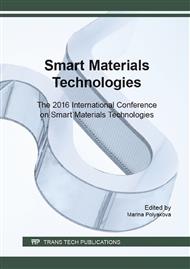[1]
Ali A, Saniddin A. B, Ezzeddin S, (2010), The Effect of Aging on Arenga Pinnata Fiber-reinforced Fiber Epoxy Composite, Material and Design (31) pp.3550-3554.
DOI: 10.1016/j.matdes.2010.01.043
Google Scholar
[2]
Derombise G, Chaillux E, Forest B, Riou L, Laconte N, Schoors V. V, Davies P (2011), Long-term Behavior of Aramid Fibres in Seawater, 52(7), pp.1366-1375.
DOI: 10.1002/pen.21922
Google Scholar
[3]
Joshi SV, Drzal L T and Mohanty S A, (2003). Are natural fiber composites environmentally superior to glass fiber reinforced composites J. Composites: Applied Science and Manufacturing , 35, pp.371-376.
DOI: 10.1016/j.compositesa.2003.09.016
Google Scholar
[4]
Ishak M. R, Leman Z, Sapuan S. M, Salleh M. Y, Misri S, (2009), The Effect Sea Water treatment On Infact And Flexural Strength Of Sugar Palm Fibre Reinforced Epoxy Composites, Mechanical and Material Engineering 4(3), pp.216-320.
Google Scholar
[5]
Ishak M. R, Sapuan S. M, Leman Z, Rahman M.Z. A, Anwar U.M. K, (2012) Charakterization of Sugar Palm (Arenga Pinnata) Fiber Tensile and Thermal Properties, J. Therm Anal Calorim (2012) pp.981-989.
DOI: 10.1007/s10973-011-1785-1
Google Scholar
[6]
Ishak M.R., Sapuan S.M., Leman Z., Rahman M.Z.A., Anwar U.M.K., Siregar J.P. (2013), Review, Sugar Palm (Arenga Pinnata): its fibres, polymers and composites., Carbohidrate Polymers, 91 pp.699-710.
DOI: 10.1016/j.carbpol.2012.07.073
Google Scholar
[7]
Leman Z, Sapuan S. M, Azwam M, Ahmad M.M.H. M, Maleque M. A, (2008).
Google Scholar
[8]
Mardin H., Wardana. I.N.G., Pratikto., Suprapto W., ( 2015), Effects of Sugar Palm Fiber Immersed In Sea Water Toward the Fiber Tensile Strenght As A Composite Strengthen, International Journal of Applied Engineering Research 10 (7) p.17037.
DOI: 10.4028/www.scientific.net/kem.724.39
Google Scholar
[9]
Pai. Avinash R., and Jagtap. Ramanand N, (2015), Surface Morphology & Mechanical properties of Some unigqui Natral Fibre Reinforced Polymer Composites-A Review, J. Mater Environ. Sci 6(4) pp.902-917.
Google Scholar
[10]
S. J Hinder., C. Lowe., J.T. Maxted., J.F. Watts, (2005), The Morphology and Topography of Polymer Surfaces and Interfaces Exposed by Ultra-low-angle Microtomy, Journal of Materials Science 40. pp.285-293.
DOI: 10.1007/s10853-005-6081-7
Google Scholar


